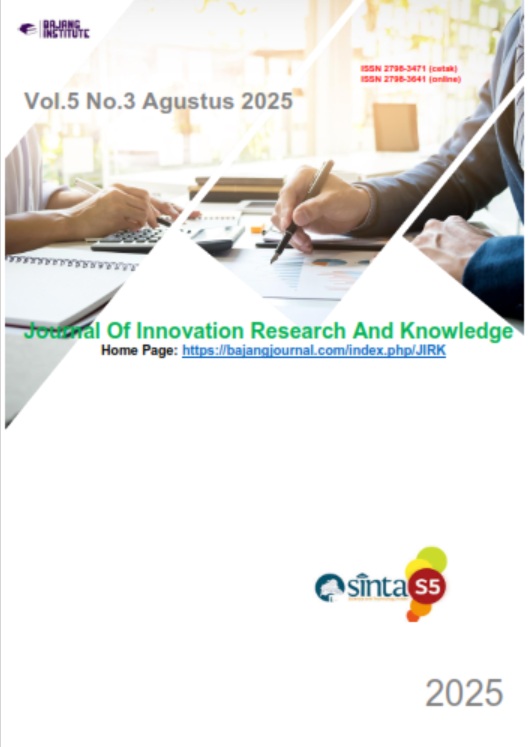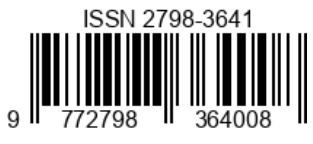DIABETES MELLITUS TIPE 2: PATOFISIOLOGI MOLEKULER SERTA EFEKTIVITAS PERAN ANTIOKSIDAN, PENGHAMBAT Α-GLUKOSIDASE DAN DIPEPTIDIL PEPTIDASE-4
Abstract
Diabetes mellitus merupakan salah satu permasalahan kesehatan global dengan angka kejadian global diabetes yang terus meningkat dari waktu ke waktu. Angka ini diperkirakan akan terus meningkat mencapai 643 juta dan 783 juta di tahun 2030 dan 2045. Review ini bertujuan mendeskripsikan patofisiologi diabetes mellitus yang berfokus pada defisiensi dan resistensi insulin, termasuk uraian mekanisme molekulernya. Pembahasan juga disertai keterkaitan enzim α-glukosidase, hormon inkretin dan enzim dipeptidil peptidase-4 pada progres diabetes mellitus tipe 2, yang dilengkapi mekanisme molekulernya. Review ini juga meninjau peran kelas terapi penghambat enzim α-glukosidase, dan dipeptidil peptidase-4 disertai potensi peran antioksidan dalam mengatasi progres diabetes mellitus tipe 2. Review artikel ini disusun menggunakan penelusuran literatur, dengan berbagai kata kunci sesuai dengan pembahasan, dengan kriteria jurnal dari tahun 2020 – 2025 yang diharapkan dapat menjadi landasan ilmiah yang kuat dalam pembahasan sehingga memberikan pemahaman yang komprehensif. Review ini menunjukkan peran penting dari antioksidan, penghambat α-glukosidase dan enzim dipeptidil peptidase-4 dalam mengatasi diabetes mellitus tipe 2, dimana antioksidan membantu mengurangi stres oksidatif yang berkontribusi pada kerusakan sel dan komplikasi terkait diabetes, penghambat α-glukosidase memperlambat penyerapan karbohidrat di saluran pencernaan, dan penghambat DPP-4 meningkatkan kadar inkretin, yang merangsang pelepasan insulin sehingga membantu pengendalian gula darah secara lebih efektif. Kombinasi tindakan ini dapat memperbaiki kontrol glikemik dan mengurangi risiko komplikasi diabetes.
References
Alqahtani, Ali S., Syed Hidayathulla, Md Tabish Rehman, Ali A. Elgamal, Shaza Al-Massarani, Valentina Razmovski-Naumovski, Mohammed S. Alqahtani, Rabab A. El Dib, and Mohamed F. Alajmi. 2020. “Alpha-Amylase and Alpha-Glucosidase Enzyme Inhibition and Antioxidant Potential of 3-Oxolupenal and Katononic Acid Isolated from Nuxia Oppositifolia.” Biomolecules 10, no. 1. https://doi.org/10.3390/biom10010061.
Boer, Geke Aline, and Jens Juul Holst. 2020. “Increatin Hormones and Type 2 Diabetes Mellitus - Mechanistic Insights and Therapeutic Approches.” Biology 9, no. 473: 1–20.
Boyko, Edward J, Balazs Esztergalyos, Sanju Gautam, Bruno Helman, Moritz Pinkepank, Adilson Randi, Agus Salim, Katherine Wallis, Beatriz Yanez Jimenez, and Margaux Ysebaert, eds. 2021. IDF Diabetes Atlas. IDF. 10th ed. Vol. 64. Brussels, Belgium: IDF. https://doi.org/10.1242/jeb.64.3.665.
Darenskaya, M. A., L. I. Kolesnikova, and S. I. Kolesnikov. 2021. “Oxidative Stress: Pathogenetic Role in Diabetes Mellitus and Its Complications and Therapeutic Approaches to Correction.” Bulletin of Experimental Biology and Medicine 171, no. 2: 179–89. https://doi.org/10.1007/s10517-021-05191-7.
Dirir, Amina M., Marianne Daou, Ahmed F. Yousef, and Lina F. Yousef. 2021. A Review of Alpha-Glucosidase Inhibitors from Plants as Potential Candidates for the Treatment of Type-2 Diabetes. Phytochemistry Reviews. Vol. 1. Springer Netherlands. https://doi.org/10.1007/s11101-021-09773-1.
Elsayed, Ahmed K, Selvaraj Vimalraj, Manjula Nandakumar, and Essam M Abdelalim. 2021. “Insulin Resistance in Diabetes : The Promise of Using Induced Pluripotent Stem Cell Technology.” World Journal of Stem Cells 0210, no. 3. https://doi.org/10.4252/wjsc.v13.i3.221.
Galicia-Garcia, Unai, Asier Benito-Vicente, Shifa Jebari, Asier Larrea-Sebal, Haziq Siddiqi, Kepa B. Uribe, Helena Ostolaza, and César Martín. 2020. “Pathophysiology of Type 2 Diabetes Mellitus.” International Journal of Molecular Sciences 21, no. 17: 1–34. https://doi.org/10.3390/ijms21176275.
Garber, Alan J., Yehuda Handelsman, George Grunberger, Daniel Einhorn, Martin J. Abrahamson, Joshua I. Barzilay, Lawrence Blonde, et al. 2020. “Consensus Statement by the American Association of Clinical Endocrinologists and American College of Endocrinology on the Comprehensive Type 2 Diabetes Management Algorithm - 2020 Executive Summary.” Endocrine Practice 26, no. 1: 107–39. https://doi.org/10.4158/CS-2019-0472.
Ghasemi-Dehnoo, Maryam, Hossein Amini-Khoei, Zahra Lorigooini, and Mahmoud Rafieian-Kopaei. 2020. “Oxidative Stress and Antioxidants in Diabetes Mellitus.” Asian Pacific Journal of Tropical Medicine 13, no. 10: 431–38. https://doi.org/10.4103/1995-7645.291036.
Kanwugu, Osman N, Tatiana V Glukhareva, Irina G Danilova, and G Elena. 2021. “Natural Antioxidants in Diabetes Treatment and Management : Prospects of Astaxanthin.” Critical Reviews in Food Science and Nutrition 0, no. 0: 1–24. https://doi.org/10.1080/10408398.2021.1881434.
Khan, Ahmad Nawaz, Rahmat Ali Khan, Mushtaq Ahmad, and Nadia Mushtaq. 2020. “Role of Antioxidant in Oxidative Stress and Diabetes Mellitus.” Journal of Pharmacognosy and Phytochemistry 3, no. 6: 217–20. https://doi.org/10.47485/2693-2458/1009.
Khutami, Chindiana, Sri Adi Sumiwi, Nur Kusaira, and Khairul Ikram. 2022. “The Effects of Antioxidants from Natural Products on Obesity , Dyslipidemia , Diabetes and Their Molecular Signaling Mechanism.”
Li, Mengwei, Xiaowei Chi, Ying Wang, Sarra Setrerrahmane, Wenwei Xie, and Hanmei Xu. 2022. “Trends in Insulin Resistance: Insights into Mechanisms and Therapeutic Strategy.” Signal Transduction and Targeted Therapy 7, no. 1: 216. https://doi.org/10.1038/s41392-022-01073-0.
Moens, Celine, Christo JF Muller, and Luc Bouwens. 2022. “In Vitro Comparison of Various Antioxidants and Flavonoids from Rooibos as Beta Cell Protectants against Lipotoxicity and Oxidative Stress-Induced Cell Death.” PLoS ONE 17, no. 5: 1–16. https://doi.org/https://doi.org/10.1371/journal.pone.0268551.
Ohiagu, Franklyn O., Paul C. Chikezie, and Chinwendu M. Chikezie. 2021a. “Pathophysiology of Diabetes Mellitus Complications: Metabolic Events and Control.” Biomedical Research and Therapy 8, no. 3: 4243–57. https://doi.org/10.15419/bmrat.v8i3.663.
———. 2021b. “Pathophysiology of Diabetes Mellitus Complications: Metabolic Events and Control.” Biomedical Research and Therapy 8, no. 3: 4243–57. https://doi.org/10.15419/bmrat.v8i3.663.
Pasupuleti, Visweswara Rao, Chandra Sekhar Arigela, Siew Hua Gan, Sirajudeen Kuttulebbai Nainamohamed Salam, Kumara Thevan Krishnan, Nurhanan Abdul Rahman, and Mohammad Saffree Jeffree. 2020. “A Review on Oxidative Stress, Diabetic Complications, and the Roles of Honey Polyphenols.” Oxidative Medicine and Cellular Longevity 2020. https://doi.org/10.1155/2020/8878172.
Pérez-García, Ana, Marta Torrecilla-Parra, Mario Fernández-De Frutos, Yolanda Martín-Martín, Virginia Pardo-Marqués, and Cristina M. Ramírez. 2022. “Posttranscriptional Regulation of Insulin Resistance Implications for Metabolic Diseases.” Biomolecules 12, no. 2. https://doi.org/10.3390/biom12020208.
Pilszyk, Aleksandra, Magdalena Niebrzydowska, Zuzanna Pilszyk, Magdalena Wierzchowska-Opoka, and Żaneta Kimber-Trojnar. 2022. “Incretins as a Potential Treatment Option for Gestational Diabetes Mellitus.” International Journal of Molecular Sciences 23, no. 17. https://doi.org/10.3390/ijms231710101.
Shaikh, Sibhghatulla, Eun-ju Lee, Khurshid Ahmad, Syed-sayeed Ahmad, Jeong-ho Lim, and Inho Choi. 2021. “A Comprehensive Review and Perspective on Natural Sources as Dipeptidyl Peptidase-4 Inhibitors for Management of Diabetes.” Pharmaceuticals 14, no. 591: 1–18. https://doi.org/https://doi.org/10.3390/ph14060591.
Singh, Anju, Ritushree Kukreti, Luciano Saso, and Shrikant Kukreti. 2022. “Mechanistic Insight into Oxidative Stress-Triggered Signaling Pathways and Type 2 Diabetes.” Molecules 27: 950–69. https://doi.org/https://doi.org/10.3390/molecules 27030950.
Singh, Atamjit, Nikhita Ghai, and Preet Mohinder Singh Bedi. 2022. “Molecular Mechanisms Involved in Insulin Resistance: Recent Updates and Future Challenges.” In Evolving Concepts in Insulin Resistance, edited by Dr. Marco Infante, 1–19. IntechOpen. https://doi.org/http://dx.doi.org/10.5772/intechopen.104806.
Suresh, Varuna, Amala Reddy, Pavithra Muthukumar, and Thendarl Selvam. 2021. “Antioxidants: Pharmacothearapeutic Boon for Diabetes.” In Antioxidant : Benefits, Sources, and Mechanism of Action, edited by Viduranga Waisundara, 1–8. London: IntechOpen. https://doi.org/10.5772/intechopen.98587.
Tan, Qiming, Seun E. Akindehin, Camila E. Orsso, Richelle C. Waldner, Richard D. DiMarchi, Timo D. Müller, and Andrea M. Haqq. 2022. “Recent Advances in Incretin-Based Pharmacotherapies for the Treatment of Obesity and Diabetes.” Frontiers in Endocrinology 13, no. March: 1–16. https://doi.org/10.3389/fendo.2022.838410.
Tomic, Dunya, Jonathan E. Shaw, and Dianna J. Magliano. 2022. “The Burden and Risks of Emerging Complications of Diabetes Mellitus.” Nature Reviews Endocrinology 18, no. 9: 525–39. https://doi.org/10.1038/s41574-022-00690-7.
Yin, Ruili, Yongsong Xu, Xin Wang, Longyan Yang, and Dong Zhao. 2022. “Role of Dipeptidyl Peptidase 4 Inhibitors in the New Era of Antidiabetic Treatment.” Molecules 13, no. 2: 85–96. https://doi.org/10.4239/wjd.v13.i2.85.















